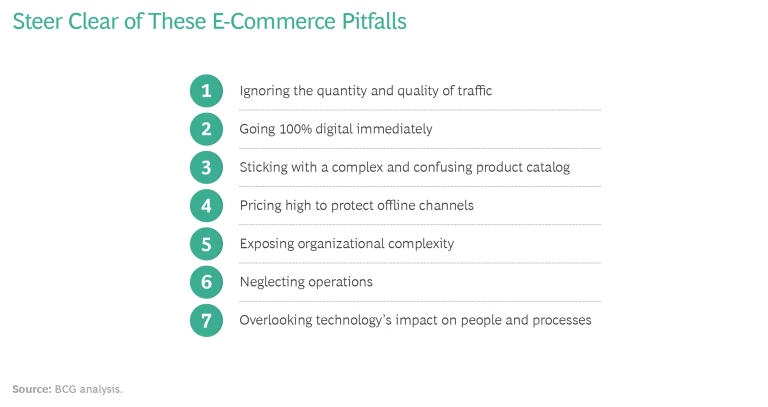The traditional relationship between buyer and seller is mostly a thing of the past. It’s rare these days for both sides of a B2B negotiation to agree to a deal while out for lunch or playing nine holes of golf. Instead, we’ve all grown accustomed to the instant gratification of a seamless e-commerce transaction. And after a year of remote work and limited in-person interactions, we’re even more comfortable buying, selling, and networking online.
Despite this, many B2B companies have yet to make a successful transition to e-commerce. According to BCG research, 60% of leading B2B companies had either no or limited e-commerce capabilities at the start of the pandemic. Leaders in the B2B space have spent most of the past year in firefighting mode, trying to rapidly build and enhance their digital platforms. However, based on our experience working on more than 600 e-commerce strategy and execution projects over the past ten years, we know that the approach taken by most companies does not lead to long-term success. Without a viable, user-friendly option for selling products and services online, B2B organizations will not remain competitive.
If only it were as simple as sticking a shopping cart on a website.
Instead, B2B leaders must understand the complexities of e-commerce in order to craft the best strategy and approach—and create lasting value.
WHAT’S TRIPPING UP E-COMMERCE ENDEAVORS
Why are companies struggling to turn online sales into important wins? In our work with B2B companies across regions and industries, we’ve seen the same seven pitfalls trip up online endeavors again and again. (See the exhibit.)
Ignoring the Quantity and Quality of Traffic. You can build the best digital experience in the world, but if you don’t have the right visitors, who are inclined to buy what you want to sell, results will fail to impress.
It’s also true in the brick-and-mortar world. Let’s say you invest in an incredible, experience-packed store, where customers can participate in virtual-reality adventures or challenge themselves on a rock-climbing wall. If that store is located in a remote area without a steady stream of potential shoppers, its bells and whistles will have little influence. Conversely, a barebones store, thinly staffed and simply stocked, can pull in a huge volume of sales if it sits in the middle of the SoHo neighborhood of Manhattan.
Traffic matters, both in terms of quantity and quality. Companies often begin their digital-sales journey by investing heavily in an impressive platform. But if their website gets little traffic, sales will, of course, be slow. And even if the website pulls in substantial visitors, they may not be there to buy. The website of a major telco, for example, could attract users interested in reading an article about 5G or wanting to pay a bill—not looking to buy IT services for their companies.
It’s crucial to plan for and invest in the digital experience—and the traffic. This requires building a robust digital marketing plan from the start and making updates as sales evolve.
Going 100% Digital Immediately. Understanding that digital sales have enormous potential, B2B leaders often shift all their offerings to the online format. Although consumers are increasingly shopping online, most keep one foot in the physical world, even amid a pandemic. This is particularly true in the B2B space, where buyers have so far been reluctant to shop exclusively online.
Part of the reason companies embrace an all-or-nothing approach to e-commerce is that the digital team is isolated—far removed from the traditional sales team within the business structure. If potential buyers choose a product, go through the steps of the checkout process, and then leave on the last page, it’s an indication that they may have been willing to buy at a lower price. In fact, the inability to negotiate is one of the top reasons that B2B customers haven’t made the shift to online buying.
But if you can start to break down the silos between digital and traditional sales, you can create a hybrid buying experience that delivers value. For example, if a potential buyer makes it to the last step and then gives up, a sales representative can reach out by phone to help close the deal. The person-to-person interaction can be brief, as the customer has already put in the time to find the desired product or service. But this way, the customer is more comfortable with the final price and overall experience.
Sticking with a Complex and Confusing Product Catalog. Historically, B2B organizations customize products and services, leading sometimes to thousands of variations that are clearly designed to be sold by people and not machines. This introduces challenges in an online environment.
To find success in the digital sales arena, B2B companies have to understand the online shopper’s mindset and streamline their catalog to a good-better-best set of offerings that can be presented in a simplified way online. This goes against B2B instincts, but it’s the way of the digital world. If companies take their current configurations of offerings and try to sell them online, the complexity will send buyers to the competition.
To find success in the digital sales arena, B2B companies have to understand the online shopper’s mindset.
Pricing High to Protect Offline Channels. B2B leaders often feel compelled to protect their legacy sales channels by increasing prices online. The thinking is that lower online pricing will undercut the ability of sales reps to negotiate the highest price possible. But this is misguided for multiple reasons.
First, customers today are counting on landing at the floor price, leaving sales reps with less leverage than they hoped for. Second, buyers are savvy online, often comparing multiple sites that have the same service or product. Companies that put a higher price online could be disqualifying themselves from ever reaching the negotiation stage.
Finally, inflating online prices just doesn’t make sense. Digital sales—without the cost of salespeople—are cheaper, faster, and easier to operate. By following the lead of successful B2C e-commerce, B2B companies should also pass along to the customer some of the savings garnered from those simple online sales.
Getting pricing right is a crucial part of winning at e-commerce. So far, B2B companies have been steering themselves off course. To ease concerns about cannibalizing the success of sales reps, consider creating digital-specific SKUs and offerings so that the online and offline propositions are slightly different. But don’t expect to bring your top offline prices online and see a big jump in digital sales.
Exposing Organizational Complexity. It’s unfortunately all too common for B2B enterprises with many product lines and channel structures to expose their complexity online.
You may have ten different business units, each with its own digital budget and ability to set up webpages. But to win at digital sales, B2B companies must work to streamline the version of themselves that they show to buyers by developing an organizational and operational model that offers a seamless customer experience. Without that, the customer can get lost in the complexity and will be left feeling discouraged from making a first transaction, let alone coming back for more.
The best web design involves simplicity and no buying frictions at all. When leaders allow web design by committee—with everyone wanting their own nuance—the results will be disappointing.
Neglecting Operations. When salespeople are engaging with customers and can provide explanations, it’s easier to paper over glitches. But e-commerce, which by necessity offers more transparency and real-time visibility, tends to expose operational and technical problems.
One of the most important operational features of online shopping is delivery speed. Because of the expectations set by the likes of Amazon, B2C shoppers generally want delivery to take no longer than three days—and the same-day delivery trend is adding further pressure. Today’s B2B buyers have similar expectations. Companies stuck at a delivery rate measured in weeks or months will not meet customer needs.
Overlooking Technology’s Impact on People and Processes. Whether you’re installing a new ordering system, adding a customer relationship management (CRM) program, or launching an e-commerce platform, you need a well-defined plan. And that plan should not focus solely on technology; people and processes play an important role, too.
Your plan shouldn’t focus solely on technology; people and processes play an important role, too.
And while the customer experience on the front end is key, companies also need to provide their own employees, who are involved each day at the back end, with the best merchandising, sales, and operations tools possible. New commercial, off-the-shelf software packages make this easier than ever. Instead of relying on IT departments to enable new features and functionality, business users themselves are now often able to create, manipulate, and extend the digital capabilities that come with e-commerce, CRM programs, and marketing systems.
WINNING WITH A HOLISTIC APPROACH
No magic platform will deliver B2B e-commerce success. Company leaders will only gain advantage when they design a holistic e-commerce strategy—one that adequately addresses each of the complexities above. The B2B companies that can lead the way will have people with the right skills and agile mindsets, who are able to conquer the intricate issues of traffic and marketing, channel and hybrid journeys, products, pricing, navigation, operations, and technology.
A great platform and technical prowess are certainly necessary, but vision and strategy are just as important when facing the realities of e-commerce today. Across industries, digital sales are outpacing traditional forms of commerce, and consumer expectations are shifting fast. E-commerce requires real-time, data-driven decision making; a test-and-learn culture of experimentation; and seamless collaboration among marketing, sales, supply chain, and digital teams.
It takes a fundamentally different set of capabilities to win in e-commerce. A well-defined strategic agenda will help companies avoid the many pitfalls and evolve into fine-tuned, future-ready digital sellers.







